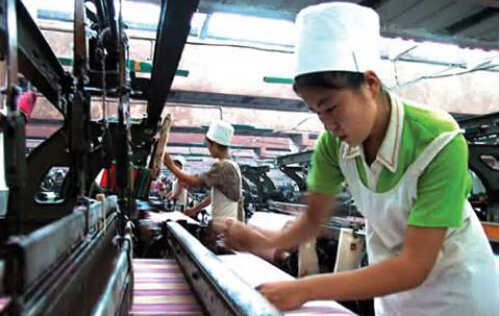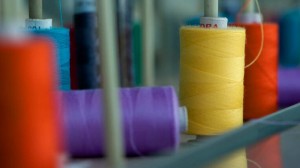In recent years, China’s manufacturing industry holds an important position, is developing rapidly, while the textile and apparel industry has made rapid development. In the next few years, the textile and garment industry should be how to develop? The new dividend future of the industry and the new path and what?

December 6, 2013, by the China Textile Industry Association’s “2013 China Textile Innovation Annual Meeting” was held in Beijing. China Textile Industry Association vice president of Sun Rui Zhe, made a presentation entitled “New bonus industrial development – New Wave and the new path,” the theme of the report, in recent years, and the next few years, the textile and garment industry has done a detailed analysis.
Analysis of old and new bonus heritage
The report first analyzes the power source textile and apparel industry in recent years of development. Sun Rui Zhe believes that the rapid development of textile and garment industry, mainly due to the three traditional bonus – bonus elements, and market development dividend bonus. Bonus factor, the rapid development of the textile industry to fully benefit from low-cost labor and land supply, the higher the environmental capacity, despite fluctuations in raw material prices but relatively stable compared to other countries, energy supply is also very stable.
Bonus aspects of development, in terms of long-term on domestic economic construction as the center, high degree of market sectors. Internationally, cross-border capital flows and international industrial division of labor adjustment to promote industrial development. Research and development, the introduction of absorption and innovation mode and gradually become mature technological innovation and research mechanisms bonus. Development model, the domestic industry chain supporting export-oriented strategy led to the cluster effect, these right development model has become a development dividend textile and apparel industry.
The bonus is mainly reflected in the market in two ways. Sustained world economic growth in recent years, the rapid development of economic globalization, China’s accession to the WTO and opening up the international market driven, sustained growth in domestic urban and rural residents’ income is driven by the development of the domestic market.
Admittedly, the textile and apparel industry is on the decline over the traditional bonus and dilution. So over the next few years, the industry has a new bonus, what does? Sun Rui Zhe analysis, “CPC Central Committee on deepening reform of the overall number of major issues” in a number of statements were positive in the textile industry. Among them, the “market allocation of resources play a decisive role in the” system helps to straighten the cotton textile industry, supporting links to the upstream raw materials, textile and garment enterprises to go; “national governance systems and governance capacity modernization” is conducive to the development of trade and industry policy the full range of coordinated designs; “public ownership as the mainstay, the basic economic system of common ownership of economic development,” it will help the textile industry to break the monopoly of non-public economic thresholds for some industries, for the industry to reinvigorate and consolidate the status of livelihood industries; “integrated rural development “has helped to promote agriculture, the city with rural workers and peasants of reciprocity, one of the new urban-rural relationship between urban and rural workers and peasants, agricultural work to help stabilize the citizens of both industrial workers, and help to stimulate consumer demand continues upgrade; “transformation of government functions,” is expected to strengthen the energy and water conservation, environment, technology, market access and safety standards, establish and improve the prevention and long-term mechanism to resolve overcapacity, which helps Forced textile industry to accelerate technological progress.
In the new situation, China’s textile industry is facing a “growth, responsibility, electricity providers, extension, integration” as the main content and features of the New Wave, which is the new bonus next development of China’s textile industry.
The first is growth, improve the level of urbanization has led to population, the domestic market, applications “growth.” This will open up new space for industrial development. 2020, total global fiber demand will exceed 100 million tons, compared with 2012 increased by 20 million tons. China’s textile industry in the domestic and international market share basically stable, processing about 14 million tons of total fiber is still room for growth. China’s textile and garment enterprises in the future development opportunities and core competitiveness of enterprises will mainly depend on the sustainable development strategy and the ability to perform actions on how innovative employees, customers, the environment and consumers and other stakeholders will fundamentally determine responsibility production efficiency, market access and brand and business performance.
After the textile and garment enterprises to grow, “social responsibility” will be given new meaning, that is, from concerned stakeholders to influence stakeholders, from the obligation to take the initiative to drive passive driver responsibility, from the “self-interest” to “altruism.” People’s livelihood, environmental protection, security and fair “responsibility”, a new direction for industrial development guidelines.
The rapid development of e-commerce, especially in mobile provider, will create a new platform for industrial development. E-commerce will bring change business model: homogeneity to heterogeneity of the transition, namely the “small front-end”, “big data background”, “one-stop service platform” three fusion; variations of production: large-scale standardized, low-cost to segmentation, personalization, fast fashion change – “production-oriented” to “market ability.” Currently, the extension within the textile industry already has four major trends: the R & D and brand building extension, the extension to the upstream or downstream areas, interdisciplinary extension, cross-regional extension.
Explore the upgrade path
The face of a new wave of development has brought dividends, the textile and apparel industry to explore new paths in the industry on how to upgrade it?
Sun Rui Zhe from technological innovation and innovation patterns were analyzed this issue. The first is technological innovation in the new developments, technological innovation and mission-critical, first, to protect the raw material supply, the second is to protect the ecological environment, conserve resources and energy Third, Fourth, to meet the new demands of society.
Guarantee the supply of raw materials is an important factor in reducing costs. The current domestic cotton low efficiency, high planting costs and market prices, decline in quality, it is difficult to create a competitive advantage for the downstream processing industry chain. Important chemical raw materials subject to environmental protection and the impact of public opinion, a number of large construction projects stalled, become a bottleneck hidden chemical raw materials. Chemical simulation technology, waste fiber recycling technology research and development need to be further strengthened in the application development industry, the real role to play in conflict areas to alleviate the shortage.
Protecting the environment is more reflects the corporate social responsibility. Recently, more and more enterprises begin to adopt eco-friendly clothing materials. Some supermarkets clothing sales area, the use of natural cotton and other eco-friendly materials more and more goods. Overall, the mall, “consider both environmental and yet fashionable” good merchandise sales momentum. However, the eco-friendly type of clothing in order to have a place in the market also needs hard work.
Saving resources and energy is an important complement to guarantee the supply of raw materials, but also to implement the scientific concept of development, transformation of economic growth, alleviate resource constraints fundamentally, reducing pressure on the environment, the inevitable choice to achieve sustainable goals of building a moderately prosperous society and economic development. Although China’s total energy resources more, but less per capita, with the advance of industrialization and urbanization, the total demand for energy resources will increase, resource constraints faced by the contradiction between economic development will be a long time. Thus, conservation of resources and energy, and vigorously promote the efficient use of energy resources and recycling, is to ease the contradiction between energy resource constraints fundamental way.
An important path to meet the new needs of the community but also the transformation and upgrading of the textile and apparel industry, textile and garment industry in the full market today, people are no longer satisfied simply warm clothing features many functional fabrics came into being, and clothing research and development thinking also has a new direction, such as outdoor clothing, radiation protection clothing, clothing antibacterial, anti PM2.5 masks and so on.
Followed by model innovation, superior strategy, specialization strategy, international strategy is the new path China’s textile and garment enterprises can select. Excellent strategy based on market segmentation and competitor actions, the pursuit of product quality, intellectual property rights, innovation, products and services, excellent brand of; professional and successful strategies from the core technology, sustainability and brand appeal; Chinese enterprises internationalization step is from the product “going out” enterprises “going out” to brand “going out.”
Ministry of Industry and Information Technology chief engineer Zhu Ren pointed out that China’s textile industry is currently in a critical period of transformation and upgrading, the industry is necessary to calmly deal with domestic costs continued to rise, increasing pressure on resources and the environment, accelerate the global industrial structure adjustment challenges, more to seize the opportunity for domestic consumption as well as upgrades to bring the round to deepen reform, accelerate the formation of technology, brand, green development as the core of new competitive advantages, promote the transformation of the textile power to a textile powerhouse.
Finally, the Chinese textile enterprises should pay attention to, and efforts to create “smart as a breakthrough in materials innovation,” “goal-oriented fashion spending power”, “force to environmental responsibility Forced-powered” and “social favored basis attractive “to accelerate the construction of textile technology powerhouse, brand power, power, power in the process of sustainable human development.
